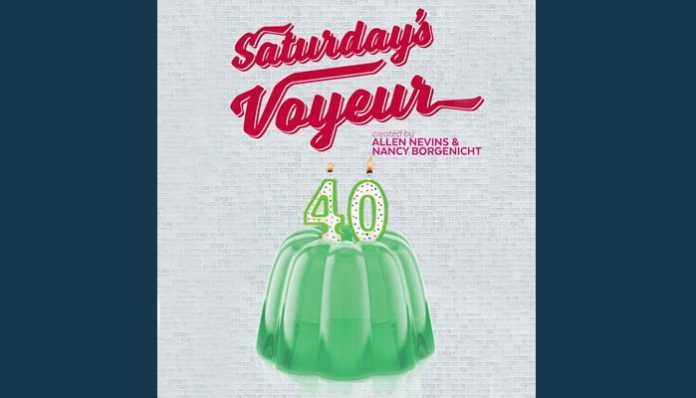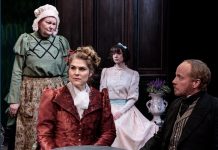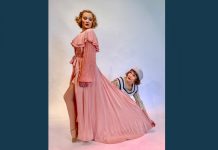SALT LAKE CITY, Utah, July 8, 2018 (Gephardt Daily) — It’s hard to believe that the annual musical satire “Saturday’s Voyeur” is turning 40 this year. The first “Voyeur” I saw would have been in 2002, months after I moved to Utah from England. It was the one about the fictional gun-toting town of La Virgin, based of course, on La Verkin. That was 16 years ago, and even that feels like a long time!
“Saturday’s Voyeur,” for those who are unfamiliar, is Salt Lake Acting Company’s parody of local and national politics, culture and religion, written fresh every year by Nancy Borgenicht and Allen Nevins. This year, Nevins is credited as playwright and Borgenicht as lyricist. The original “Voyeur” was conceived in 1978 by Borgenicht and Michael Buttars and was structured like a Mormon Roadshow. The title, of course, is a play on “Saturday’s Warrior,” a musical written by Douglas Stewart and Lex de Azevedo, most recently made into a movie in 2016.
I think that because “Voyeur” has been running so long, some of the recent years have felt a bit muddled to me; almost as if the writers aren’t quite sure where to take the show that’s new and fresh. The writers also have to ride that fine line between funny and just mean-spirited.
However, this year’s episode, titled “Saturday’s Voyeur: Limbo,” felt like a return to basics, which worked very well, and, to me, was the funniest one I’ve seen since 2002.
The show starts with a medley of songs from the original 1978 version. The scene then shifts as the roadshow’s director, DeLoy Smoot (Eric Lee Brotherson), chokes to death, after an allergic reaction to hazelnuts in his wife’s cookies, and wakes up in Spirit Prison.
We then meet characters from 1978 trapped in the Prison, awaiting their eternal fate. Longtime “Voyeur” fans will recognize classic characters and songs, alongside contemporary storylines that tackle the #MeToo movement, gay emancipation and a woman’s role in the Church.
What the writers have done this year is take some of the best-loved scenes from vintage Voyeurs and given them a fresh twist, yet kept them recognizable.
I actually didn’t know which scenes were sourced from the original show, since I was four years old and in England when “Voyeur” started.
But I asked the director, SLAC Executive Artistic Director Cynthia Fleming, afterwards, and funnily enough, each one of my favorite scenes and songs — the opening medley, the Bishop’s Interview, the Missionary Medley, the BYU Girls, Family Home Evening and There’s No Erection in the Resurrection — were based on vintage scenes.
As usual, it’s a three-act show, but at two-and-a-half hours long, it flies by. That’s also probably helped by the fact that you can take picnics into the theater and there are two intermissions. The audience seemed increasingly excitable as the show went on. The woman in front of us saw fit to give a steady commentary in a normal speaking voice; we oscillated between finding this hilarious and deeply irritating.
As always, the acting is outstanding. Fleming, Nevins and Borgenicht have assembled a stellar cast, and interestingly, unlike some past years, there’s a sort of relaxed feel, as if the actors are trusting the material and not trying to push too hard. Robert Scott Smith, returning as Joseph Smith (presumably no relation, though one never knows in Utah) and Olivia Custodio, returning as Heavenly Mother and Mother Thorla, are the standouts for me. The highlight of the show for me is Custodio’s Mother Thorla delivering a Family Home Evening message using a flannel board (I had to Google flannel board, must be a Utah thing) as her six children study their cellphones and her very constrained frustration threatens to boil over.
Another notable cast member for me is Devin Ray Barney, who really gets a lot of the show-stopping moments, including playing a rather sexy Angel Moroni (hold on while I get hit by lightning real quick).
The production values are solid without being too flashy; set design is by Michael Horejsi; as usual, the stage protrudes in a ‘V’ shape with the audience sitting on three sides, and there are functional set pieces that are brought on and off by actors. A welcome addition this year at the end of the show is a medley of projected photographs of past “Voyeurs”; a nod to some of the actors that have helped make the show a success. The costumes by Heidi Ortega appear to stick closely to the original designs for the vintage scenes, but then she gets a chance to add some pizzazz with costumes such as that in the S&M themed Pit Master Chuc and Moroni (both played by Barney).
“Voyeur” is a little pricey, because it essentially funds the rest of SLAC’s season, but this year, I do believe it’s worth the price. It’s a fun, fast-moving night that wisely chooses not to tackle some of the darkest things that are happening in the world right now. I’ll be interested to see where SLAC chooses to take the show thematically after this year.
“Saturday’s Voyeur” runs at 7:30 p.m. Wednesday through Saturday, and Sunday at 1 p.m. and 6 p.m., through Sept. 2. Tickets are $45 to $55, available by phone at 801-363-7522, or online here. SLAC is at 168 W. 500 North, Salt Lake City.





